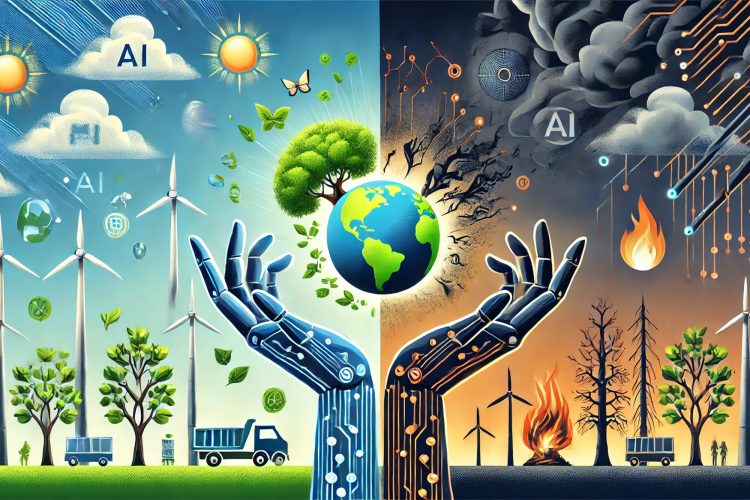Introduction: Climate Change and the Role AI Can Play in Mitigating Its Effects
Climate change stands as one of the most pressing challenges humanity faces today. Rising global temperatures, more frequent and intense weather events, shrinking ice caps, and disruptions in ecosystems are just a few of the many manifestations of climate change. As the global community seeks to mitigate these impacts, there is a growing recognition that technology—particularly artificial intelligence (AI)—can play a significant role in addressing this crisis. By harnessing the power of AI, we can better understand, monitor, and ultimately mitigate the effects of climate change.
AI’s potential to contribute to climate change solutions comes from its ability to process vast amounts of data, identify patterns, and optimize processes at a scale and speed beyond human capability. Whether in the realms of energy, agriculture, transportation, or environmental monitoring, AI can provide valuable insights and innovative solutions to reduce carbon footprints, improve resource efficiency, and help societies adapt to changing environmental conditions.
However, while AI has the potential to significantly impact climate change, it is not without its challenges. The computational resources needed to run AI systems can be energy-intensive, and the widespread deployment of AI must be approached with care to ensure that it does not exacerbate the environmental issues it seeks to solve. In this article, we will explore the current and emerging applications of AI in combating climate change, the challenges that come with its deployment, and the real-world examples of AI solutions already making a difference.
AI’s Current Impact: AI in Climate Modeling, Improving Energy Efficiency, Managing Renewable Energy, and Monitoring Environmental Changes
AI has already made substantial contributions to understanding and managing climate change. One of the most important areas where AI is having an impact is in climate modeling. Climate modeling allows scientists to simulate and predict how Earth’s climate will respond to various factors such as greenhouse gas emissions, land use changes, and other environmental variables. These models are essential in understanding the future trajectory of climate change and informing policy decisions.
AI is revolutionizing this field by improving the accuracy and efficiency of climate models. Machine learning algorithms can analyze vast datasets generated by climate observations and simulations to identify patterns and correlations that may be difficult for traditional modeling techniques to detect. These AI-enhanced models can predict climate outcomes with greater precision, helping governments, businesses, and organizations prepare for future environmental challenges and make informed decisions regarding mitigation and adaptation strategies.
In the energy sector, AI is playing a crucial role in improving energy efficiency. AI-powered systems can optimize energy consumption in buildings, factories, and even entire cities by analyzing real-time data on energy use and making recommendations for more efficient operations. For example, AI algorithms can control heating, ventilation, and air conditioning (HVAC) systems to reduce energy waste, or manage lighting and appliances to ensure optimal power consumption. These AI systems can learn and adapt to user behaviors, further enhancing their efficiency over time.
AI is also playing a critical role in the management of renewable energy sources like solar and wind power. These energy sources are intermittent and variable, and AI can help balance supply and demand by forecasting energy generation and consumption. AI systems can predict weather patterns to anticipate when solar and wind energy will be available at peak levels, and adjust the operation of grid systems accordingly to ensure that renewable energy is effectively integrated into the power grid. Additionally, AI can optimize the maintenance of renewable energy infrastructure by analyzing sensor data to predict when equipment like wind turbines or solar panels will require repairs, preventing downtime and improving their operational lifespan.
Environmental monitoring is another area where AI is making a significant impact. AI-powered systems are being used to track changes in ecosystems, biodiversity, and pollution levels. These systems can analyze satellite imagery and sensor data to detect deforestation, track wildlife populations, and monitor air and water quality in real time. By providing more accurate and timely data, AI helps policymakers and environmental organizations take swift action to address environmental degradation and protect endangered species.
Emerging AI Solutions: AI-powered Solutions in Carbon Capture, Sustainable Agriculture, Wildlife Monitoring, and Optimizing Transportation Systems
In addition to its current applications, AI is also enabling emerging solutions that have the potential to make a substantial impact on climate change mitigation efforts. One of the most promising areas is in carbon capture technologies. AI is being used to optimize the capture and storage of carbon dioxide (CO2) emissions from industrial processes. Machine learning algorithms can analyze data from various sources, such as emissions measurements and chemical reactions, to identify the most efficient methods for capturing CO2 and storing it in geological formations. AI can also help monitor these storage sites over time to ensure that the captured carbon does not leak back into the atmosphere.
Sustainable agriculture is another area where AI is playing an increasingly important role. As the global population grows, it is becoming more challenging to produce food sustainably. AI-powered technologies are helping farmers optimize crop yields while minimizing the environmental impact of agricultural practices. Machine learning algorithms can analyze soil health, weather patterns, and other environmental factors to recommend the best times to plant and harvest crops, the ideal irrigation methods, and the optimal use of fertilizers and pesticides. Additionally, AI can be used to monitor crop health in real time, detecting early signs of disease or pest infestations that could reduce yields.
AI is also playing a vital role in wildlife monitoring and conservation. By analyzing satellite imagery, drone footage, and sensor data, AI systems can track the movement and behavior of wildlife populations, helping to protect endangered species and manage protected areas more effectively. AI can also be used to combat illegal activities such as poaching and deforestation by identifying suspicious patterns in satellite images or social media posts. In this way, AI is not only helping to monitor and protect biodiversity but also assisting in the enforcement of conservation policies.
Transportation is another sector where AI is being used to reduce emissions and optimize efficiency. AI-powered systems can optimize routes for trucks, ships, and airplanes to reduce fuel consumption and minimize emissions. Self-driving electric vehicles, including cars, buses, and trucks, have the potential to transform transportation by reducing the need for human drivers and optimizing energy use. AI algorithms can also improve the efficiency of public transportation systems by predicting demand and adjusting schedules to ensure that resources are used efficiently. By optimizing transportation systems in this way, AI can help reduce the carbon footprint of one of the largest contributors to global emissions.

Challenges: Data Scarcity, Computational Resource Demands, and the Energy Consumption of AI Itself
While AI holds great promise in the fight against climate change, there are several challenges that must be addressed to ensure that its deployment is effective and sustainable. One of the primary challenges is data scarcity. AI systems require vast amounts of high-quality data to function effectively, and in some cases, the data needed to train AI models on climate-related issues may be limited or difficult to obtain. For example, data on certain environmental factors, such as ocean temperatures or soil composition, may be sparse in certain regions, making it difficult to develop accurate AI models for climate prediction or environmental monitoring.
Another significant challenge is the computational resource demands of AI systems. Training machine learning models and running AI algorithms often requires substantial computational power, which in turn requires significant amounts of energy. While AI can be used to optimize energy consumption in various sectors, the energy consumption of AI itself can be a concern, especially if the power needed for these systems is derived from non-renewable sources. In order to ensure that AI solutions are truly beneficial for the environment, it is essential to use energy-efficient hardware and renewable energy sources to power AI systems.
The environmental footprint of AI extends beyond its computational demands. Many AI systems rely on cloud computing infrastructure, which requires massive data centers that consume large amounts of electricity and generate heat. These data centers can have significant environmental impacts, particularly in regions where electricity is generated from fossil fuels. Therefore, it is crucial to implement energy-efficient practices in the design and operation of AI infrastructure to minimize the environmental impact of AI itself.
Case Studies: How Companies and Governments Are Using AI to Manage Environmental Resources More Effectively
There are already several real-world examples of AI solutions being used to address climate change and manage environmental resources more effectively. One example is Google’s use of AI to optimize energy consumption in its data centers. Google has implemented AI algorithms that analyze real-time data on energy use and adjust the cooling systems in its data centers to reduce energy consumption. This has led to a significant reduction in the energy required to run these data centers, resulting in lower carbon emissions and a more sustainable operation.
In the field of carbon capture, companies like Carbon Clean Solutions are using AI to optimize the chemical processes involved in capturing CO2 emissions from industrial plants. By analyzing data from emissions measurements and chemical reactions, AI algorithms can identify the most efficient methods for capturing CO2, reducing the overall cost and improving the scalability of carbon capture technologies.
Governments are also leveraging AI to address environmental challenges. For example, the UK’s Environment Agency has developed an AI system that analyzes satellite imagery to monitor deforestation in the Amazon rainforest. This system can detect changes in land use and identify illegal logging activities, allowing authorities to respond more quickly and effectively. Similarly, AI is being used to predict the impact of climate change on agricultural yields, helping farmers in developing countries adapt to changing environmental conditions.
Conclusion: AI Has the Potential to Significantly Contribute to the Fight Against Climate Change, but It Must Be Deployed Responsibly and With Consideration for Its Own Environmental Footprint
AI has the potential to be a powerful tool in the fight against climate change. From improving energy efficiency to optimizing renewable energy use, enhancing environmental monitoring, and supporting sustainable agriculture, AI is already making a significant impact in many sectors. However, to fully realize its potential, AI must be deployed responsibly and with consideration for its own environmental footprint.
While AI can help reduce emissions and improve resource management, the energy consumption of AI systems themselves must be carefully managed to ensure that their deployment does not exacerbate the very issues they seek to address. As we continue to develop and deploy AI solutions to combat climate change, it is essential to prioritize sustainability in both the design and operation of AI systems.
Ultimately, AI will play a critical role in shaping the future of climate change mitigation and adaptation efforts. By leveraging AI to monitor environmental changes, optimize resource use, and develop innovative solutions, we can make significant strides in creating a more sustainable future for generations to come.












































Discussion about this post